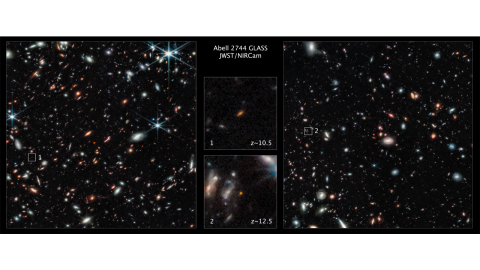How did the universe begin?
What was the universe like in the distant past? What was the beginning of the universe like? It will take at least several decades to find the above answers and fully understand the universe in the past. But thanks to the James Webb Space Telescope, which is extremely sensitive to infrared light, we are getting closer to the answer.
Astronomers explain that, as planned before launch, the James Webb Space Telescope completely changes their perspective on the universe. In particular, the aforementioned telescope, which specializes in infrared observation, shows the distant universe and suggests that stars may have formed earlier than theoretically expected.
Which galaxy is officially the oldest?
The oldest galaxy before James Webb Space Telescope observations is GN-z11, an irregular galaxy in the constellation Ursa Major observed by the Hubble Space Telescope. So far it is officially known as the most distant galaxy in the solar system and has an observed redshift value of 11.09. Converting this to distance, it’s about 13.4 billion light years, which is a galaxy only about 400 million years after the universe was born.
Officially the oldest galaxy ever observed, GN-z11 © Hubble/NASA
Astronomers use the James Webb Space Telescope to capture features of older objects that appear only in galaxies that formed shortly after the Big Bang (composed mostly of light elements and low-mass stars) and older galaxies.
However, many of the galaxies that are predicted to be old are known to require further research, such as one of the galaxies that was predicted to be very close to 13.8 billion years old turned out to be a later formed galaxy.
Discovery of primordial galaxies about 50 million years older than the oldest officially identified galaxies
An international astronomy research team led by Prof. Tommaso Treu at the University of California, Los Angeles (UCLA) reported observing GLASS-z12, a galaxy that occurred about 350 million years after the creation of the universe. (High resolution image shortcut)
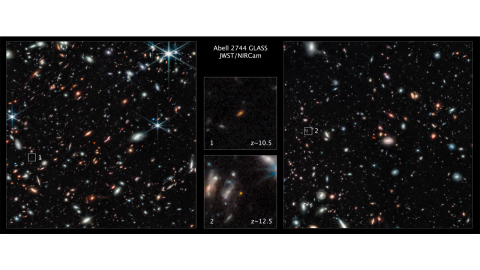
GLASS-z12 (labelled 2), a galaxy about 350 million years after the formation of the universe © NASA, ESA, CSA, Tommaso Treu (UCLA), image processing: Zolt G. Levay (STScI)
A research team led by Professor Treou used the James Webb Space Telescope to capture old galaxies around the Abell 2744 galaxy cluster (also called Pandora’s Cluster). The oldest galaxies do not exist within galaxy clusters, but exist billions of light years behind them.
The galaxy marked with (1) is a galaxy approximately 450 million years after the Big Bang, and the galaxy marked with (2) is a galaxy only 350 million years after the Big Bang. Both galaxies are very close in time to the Big Bang, which occurred 13.8 billion years ago. In particular, the elongated galaxy marked with (1) shows very small dimensions compared to our Milky Way.
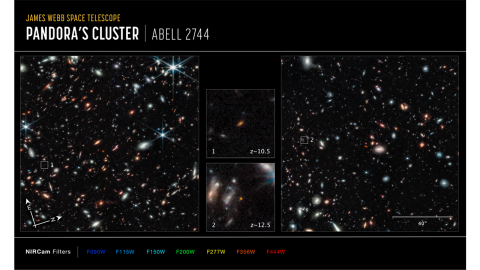
GLASS-z12 (galaxy marked 2), a galaxy approximately 350 million years after the formation of the universe © NASA, ESA, CSA, Tommaso Treu (UCLA), image processing: Zolt G. Levay (STScI)
The image above shows an image of Abell 2744 taken with the James Webb Space Telescope’s Near Infrared Camera (NIRCam), along with a scale bar (measurement of the angle from Earth when looking at the sky, measured in seconds d 1/1 of 3600, the angular diameter of the full moon is about 0.5 degrees), the north/east compass arrow shows direction when looking up at the sky and reverses when looking down. , the colors show the NIRCam filters used to collect the light, and each color represents the visible light color used to represent the infrared light passing through that filter.
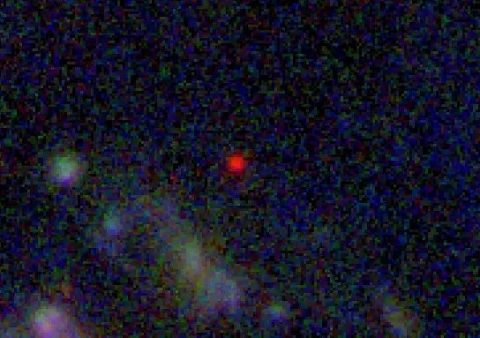
GLASS-z12 discovered last July (this galaxy was called GLASS-z13 at the time of discovery) © JWST/NASA, ESA, CSA
In fact, the aforementioned galaxy was discovered at the edge of the “Abell 2744” galaxy cluster last July. At the time of discovery, it was named “GLASS-z13” because it was predicted to have a higher redshift of z = 13.1, but later studies revealed that the redshift of the galaxy above was approximately z = 12.4 (+ 0.1-0.3) , indicating ‘ It has been renamed ‘GLASS-z12’. The aforementioned galaxy was discovered together with GLASS-z10, which is expected to compete with GN-z11, the oldest galaxy. (Links to related articles)
The research team explains that the highly sensitive NIRCam instrument completely changes our view of the universe and that the discovery of an object that existed just a few hundred million years after the Big Bang suggests that the beginning of the galaxy above may have been before thought. Do. Indeed, for the aforementioned galaxies to exist, the formation must begin only 100 million years after the Big Bang, and through this, it can be predicted that the dark age of the universe, which was composed of gas and dark matter without any light, finished much earlier than expected.
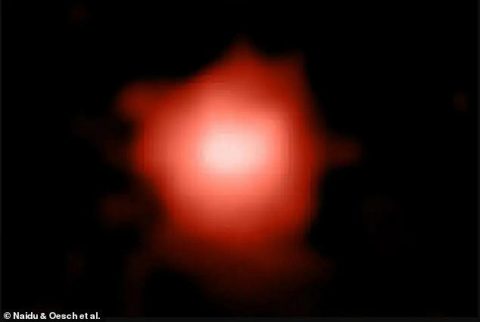
GLASS-z12 discovered last July (this galaxy was called GLASS-z13 at the time of discovery) © JWST/NASA, ESA, CSA
The research team led by Professor Treou predicted that the two galaxies discovered this time could be low-mass galaxies composed of very bright and hot Population III stars. These are first generation stars composed only of primitive hydrogen and helium, before the appearance of the heavy elements produced through stellar nuclear fusion, and are never observed astronomical objects.
(86)
